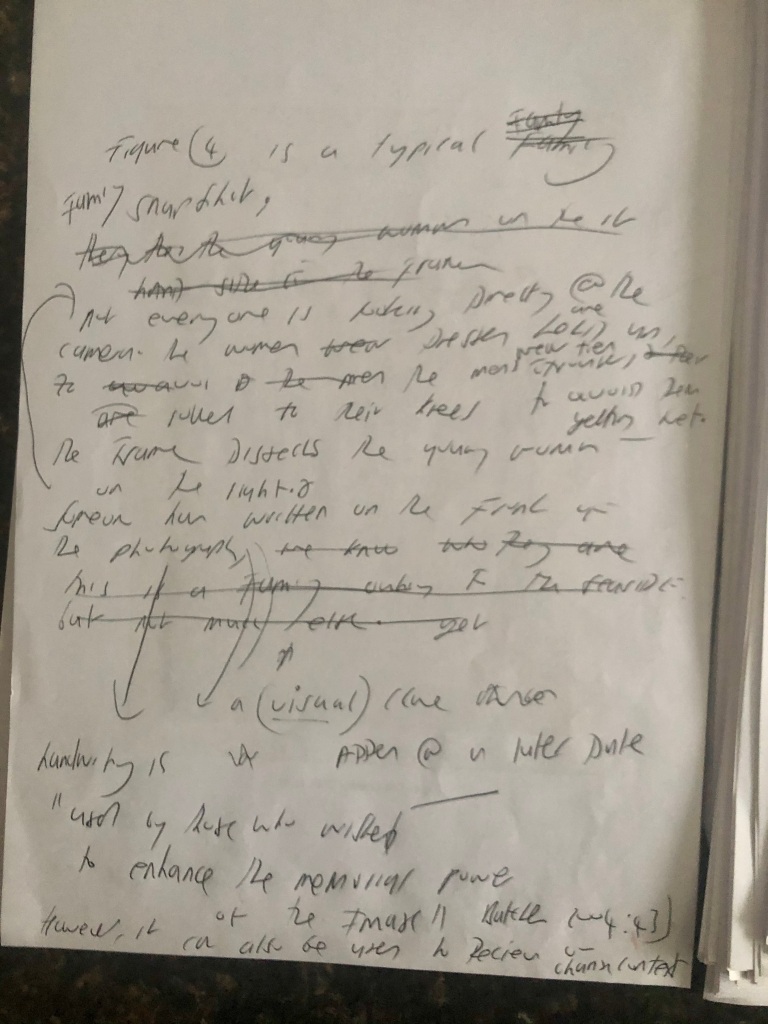Analogue photographs were not instantaneous, they were usually sent away to be developed. Nor were they easy for the amateur to replicate, hence they were considered unique objects. They are hard to throw away or destroy “unless it is someone one wishes harm, then one may burn the image in effigy” (Callahan, 2012:50).
Callahan (ibid, 20012:6) considers the “visual noise” of analogue images, their markings and ageing etc. Compare with how photographs are silenced over time.
+ SEE POSTS / LINKS BELOW
Barthes’s Camera Lucida is a subjective study of photography. The Winter Garden Photograph provides a link between past & present, Callahan suggests this is why Barthes considers “photography is not an art but magic” (ibid, 2012:14).
Barthes searches for a photograph of his mother, before finding one he knows it is categorically her. For Barthes what has been is at the core of photography’s power, time is linear, the photograph proof of a persons existence. However, this pivotal photograph is not re-produced and prior to finding the picture that penetrates him Barthes fails to identify his mother; “it was not she, and yet it was no one else” (Barthes, 2000:66). Barthes carefully scrutinises an old faded photograph of a five year old child before he finally summons her up.
The WGP is a non indexical sign ****important a photograph is supposed to be a trace.
+ SEE NOTES RE WGP links below:
Prodger, Memory Fails
Nickel, Roland Barthes and the Snapshot
Callahan (ibid, 2012:16) suggests indexicality “does not in itself have anything to do with the photograph looking like what it depicts“. How then do we recognise people, how was Barthes able to identify his mother, why and how do the affect us ? Old snapshots of aged relatives show the subject in their youth, how they once were, yet these same people have already grown old or are possibly dead. Callahan proposes it is because of “the iconographic relationship” between the subject and the person looking at the image.
The shadow of a body in an image is indexical, whilst it might be recognisable as a particular individual we cannot be totally confident it is really them. The child in the Winter Garden Photograph, Barthes’s mother, could not in certainty be her, Barthes himself declares the figure is “outside of “likeness“”. Yet, as he looks at the WGP he identifies her.
“The reality offered by the photograph is not that of truth-to-appearance but rather of truth-to-prescence, a matter of being, (of something’s irrefutable place in time) rather than resemblance” (Barthes, 2000:14).
Callahan (Callahan, 2012:17) considers how, when looking at our own photographs, we fail to disconnect the icon (the subject / person we know / knew) from the indexical. This subliminal merger generates…
“A fascination with, and emotional charge in the image: the photograph shows what someone (a mother, child, deceased relative) looked like at some point in time (icon) and we feel that the photograph is somehow directly connected to that person (index)”
N.b
- Icons: Both signifier and signified are analogous, they are recognisable. The icon resembles what it stands for.
- Indexicality: An indexical signifier is not random and can be explicitly linked to the signified. This link can be implied or seen, for example footprints indicating footsteps, smoke indicating fire.
A photograph is a sign and narrative techniques can contribute to the overall meaning, its meaning is not fixed and it can have multiple interpretations. Cultural and personal experiences will influence how an image is interpreted.The subject of a photo, unlike those in paintings, existed in time and space, they are not figments of the imagination.
“Family snapshots…are loaded with sentiment not just because of what they show but also because the camera is thought to contain a link or a trace to a particular time, a time that is inevitably gone by the time we look at the image” (Callahan, 2012: 20)
A gap exists in time between the past and present, a gap that evokes a sense of loss, of what has been.
Photographs are regarded as a mnemonic so what function can out of context and non indexical photographs perform ?
Consider artistic interventions / links below:
See M, Chandra research… emphases the nebulousness of semblance and presence. + email response .
” We can see these manipulations as highlighting the uniqueness of the photograph itself, a reminder that the photograph is always somewhat of a trick. The witness is unreliable indeed, the truth blatantly manipulated ad rewritten, figures are erased, footprints smudged and their indexical trace severed” (Callahan, 20012:34).
See C, Panebianco research…No Memory is Ever Alone + email response .
“Holding a photograph of a loved one is tantamount to connecting with that person” (Callahan, 2012:23)
See Soomin Ham
- “damaged photographs are proof of something, but it is a proof mixed with fiction” (ibid, 2012;44)
- “the frozen face is a reminder of the inevitability of time passing” (ibid, 2012: 49)
Callahan (ibid, 2012: 45) discusses the frailty and materiality of old analogue photographs. Whilst photography stops time it is also linked with death,
“they both share bodies that are fragile and perishable and that show the passage of time. The photograph, the material negative, or the image, can thus act as analogy of the physical decay of our own bodies”
+ See Barthes notes HERE.
+ see notes on Poststructuralism & the language of photography.
Consider any writing on photographs, their haptic qualities, they are touched as well as looked at. They have blemishes, rips etc. these are marks from a previous time. Someone held, touched and wrote on them, the text and markings are indexical links to the past.
+ See my Frozen (in time) series SEE post HERE
Bibliography / References
Barthes, R. (2000) Camera Lucida. London: Vintage
Callahan, S. (2012) Tracing Shadows -The “analogue” and the indexical sign-status of the photographic object. [MA thesis] Södertörn University (Stockholm)








